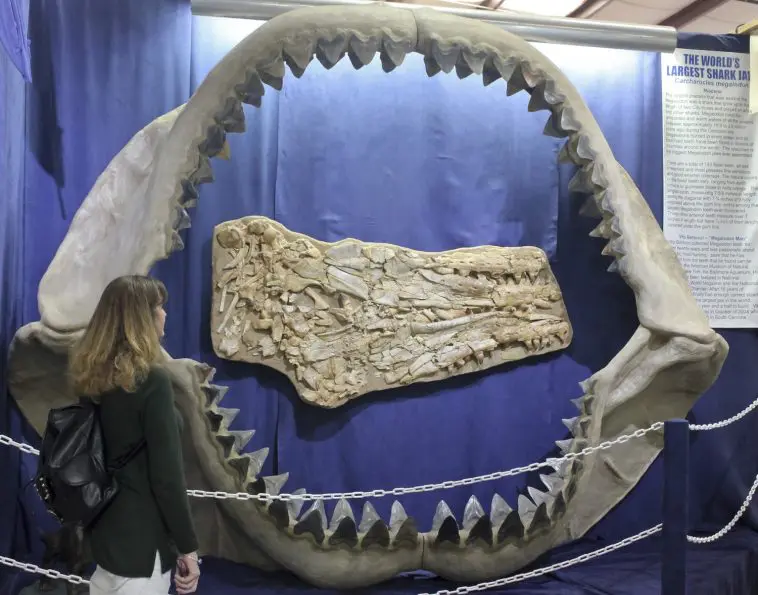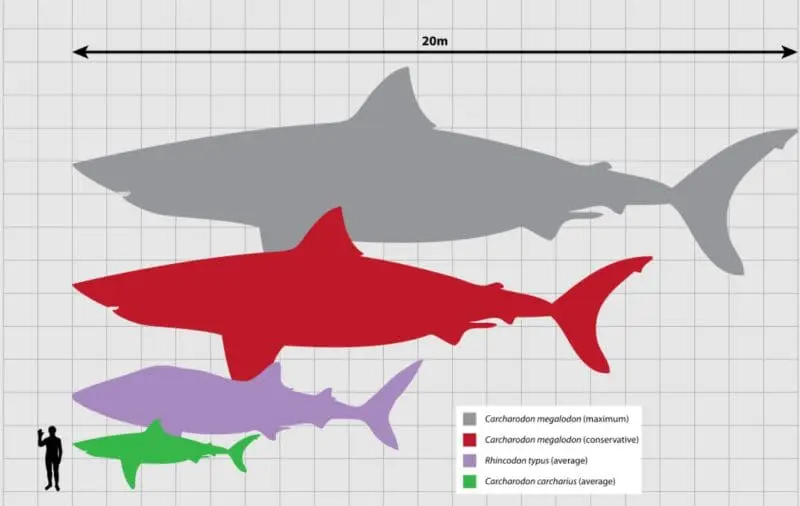[Originally published as When Teeth Talk: A Creationist Perspective on the Megalodon by Jake Ramgren]
The next time you see a bus on the highway, imagine yourself in the ocean, swimming past a shark about the same size as that bus. The next time you look at your palm, imagine a shark tooth large enough to cover your entire hand. When you use a tape measure, pull out five feet of tape. Think of a dorsal fin five feet tall, emerging from the surface of the ocean and cutting through the waves.
These are the staggering dimensions of the largest shark to ever exist: the megalodon.
They are so impressive that it is natural for people to be skeptical about modern depictions of these giant monsters. They seem to resemble a myth rather than a scientific reality. Indeed, today’s megalodon is more of a movie star than a scientific discovery.
How do we know that bus-sized sharks with 5-inch teeth once roamed the seas?
If they were powerful apex predators, why did they go extinct?
People who adhere to a young earth might hesitate to accept conventional data about these giant, “prehistoric” sharks that science says went extinct over 3 million years ago. So, as more studies are performed and more cinematic portrayals of giant sharks are released, it is time to take a constructive dive into the science of the megalodon and separate the fact from the fanfiction.
Uncovering the Facts
The term “megalodon” refers to a species of shark in the extinct family Otodontidae. The species, Otodus megalodon, is the largest shark species known to man. Conventional scientific models place the megalodon in the Miocene and Pliocene eras, which means they supposedly entered the scene 26 million years ago and died off only 3.5 million years ago.
Otodus megalodon was a macropredator, which means not only was it extremely large, but was also carnivorous. In appearance, the meg could have resembled today’s great white sharks (their teeth shape and ecological analog are similar). In fact, they were classified in the same family as white sharks for a time (bearing the name Carcharodon megalodon) before being moved into the family Otodontidae (megatooth sharks).
Describing a species that has gone extinct is a difficult task, especially for sea creatures that do not easily fossilize. So how can scientists be confident their data is accurate? How do we even know that megalodons existed in the first place? The answer is comparisons and models.
Teeth make up nearly all of the evidence we have that gargantuan sharks used to roam the seas.
The most significant evidence that the megalodon once roamed the seas is its teeth. Around the world, people have found hundreds of giant shark teeth whose owners must have dwarfed their extant counterparts.
From these teeth alone, scientists can estimate size measurements by assuming that the tooth-to-body size ratio is the same in the meg as it is in its closest living equivalent: the great white shark.1 This method of comparison brought about the first wave of megalodon data and size measurements.
The length question gets even more interesting when you factor in the vertebrae.
While shark bones virtually never fossilize, researchers have found enough vertebrae from a single specimen to construct a 3D model of the creature. This modeling technique has revealed that megalodons may have been larger, faster, and deadlier than previously thought.
Based on tooth size alone, megalodons were estimated to reach over 55 feet in length.2 Already, this total length (TL) is three times that of today’s great white sharks and easily surpasses that of transit buses. At this gargantuan size, a shark would successfully consume a killer whale in just five bites.
The 3D model, based on the discovered vertebrae, gives an altogether different story. Based on this method, they measured the megalodon at 65 feet, 7 inches long. To put this into perspective, the dorsal fin of a shark this size would be 5 feet tall! The shark’s mouth would also be wide enough to swallow a man whole.
This graph reveals how much larger the megalodon was than today’s white shark. Notice the scientific name, “Carcharodon Megalodon,” is outdated, as megalodons are no longer part of the Carcharodon genus.
The megalodon’s speed is harder to determine from just the teeth and vertebrae. Scientists abandoned older estimates of megalodon speed when they proposed that the megalodon was mesothermic, which means it could regulate its own blood temperature.
Mesothermic sea creatures (such as great whites) typically sustain higher speeds than regular, meandering, cold-blooded fish. Recent studies confidently suggest that the meg’s cruising speed was 1.3 m/s, which is easily faster than any extant species of marine macropredator. Bursts of speed would have been much faster, and some researchers suggest that current estimates are modest, since they do not account for the megalodon being mesothermic.3
Modest or no, one thing is clear: the megalodon was fast.
When it comes to diet, we can break ecology down into layers called “trophic levels.” Here, we place predatory species higher than species that tend to be prey. An apex predator — a predatory animal that has no predators of its own — sits in the highest trophic level in a given ecosystem.
Based on the available data (and common sense), researchers place megalodons in a higher trophic level than today’s great white sharks.4 While today’s white sharks eat seals and fish, the megalodon likely ate small-to-medium-sized cetaceans (whales and dolphins). It is difficult to know this for certain since macropredators today are known to eat prey considerably smaller than them. It is possible megs did not bother to eat whales and instead opted to eat sharks or other marine life.
What is known, however, is that the energy demand for megalodons would have been 20x that of white sharks.
This means megalodons would need to eat much more fat and nutrients than sharks do today. Still, whale blubber and shark livers are so energy rich that megalodons could have survived without needing to eat daily or even monthly. Extant macropredators (such as the polar bear) regularly eat more than their energy requirement.
So, it remains unclear what the megalodon ate, and how often.
Cooper et al. (2022) puts it this way:
Our results indicate that if O. megalodon hypothetically fed exclusively on the smallest prey (e.g., 2 to 3 m), it would have to eat, on average, once every 1.3 days to sustain its population. In contrast, O. megalodon could have eaten only every 145 days (i.e., 5 months) if it fed exclusively on the largest prey (e.g., >12 m).
Like most other kinds of animals, sharks (order Chondricthyes) appear suddenly in the fossil record and change relatively little throughout.
Shark size does vary substantially, which led scientists to hypothesize that shark size increased over time until the largest species went extinct, possibly due to the greater energy requirement. This hypothesis has been rejected by more recent studies, which argue instead for a theory called “stasis.”5
As the term suggests, “stasis” means that body sizes only vary within a certain fluctuating range (known as “homeostasis”). As marine environments change, that range can shrink, which drives the gargantuan megalodon to extinction. Megalodons could have been simply too large to survive in today’s environmental conditions. It turns out that many creatures have disappeared since the flood of Noah, so the poor meg’s fate is not an unusual phenomenon.
Stasis in the megalodon fossil record, naturally, fits well into a young-earth creationism framework.6 Its story is straightforward. Like all sharks, the megalodon’s ancestors were created on Day 5 of creation. Due to their mesothermic body, large size, and subsequently high energy requirements, megalodons likely went extinct in the post-Flood ice age. Such conditions — even if they lasted for a far shorter time than evolutionists believe—would have made life for the meg extremely difficult.7
Lucky for us, this legendary creature left hundreds of teeth for us to find.
Some creationists hold out hope that the megalodon was the “great fish” that swallowed Jonah when he fled from the Lord. This intriguing idea is not impossible; the meg’s mouth is large enough to swallow a man whole. The eating style of the shark, however, along with its quantity and size of teeth, would make it very difficult to swallow a man without shredding him to pieces first.8 It is more likely that a different, less toothy species swallowed and spit out the rebellious prophet.
Naturally, no article about the megalodon is complete without asking the question that gets everyone’s blood rushing:
Could the megalodon still be alive?
The answer is a disappointing (or perhaps relieving), no. Both evolutionists and creationists agree that megalodons probably went extinct due to cold ocean temperatures. There is little evidence to suggest that some megs still roam the ocean today. While history has had its coelacanths, a whale-sized shark should be fairly easy to discover.
When discussing this possibility, hopeful shark lovers love to cite statistics about how much of the ocean is unexplored and how many unknown spaces in the ocean there are. But those numbers do not mean that massive prehistoric creatures are just lingering in the unexplored niches of the sea, waiting for us to stumble upon them.
There are many ways to know something exists without running across it on some expedition. The most elusive sea creature — the giant squid — was first discovered by sailors who observed sucker marks on sperm whales. Today, dead bodies of the 30-foot cephalopod occasionally wash up on beaches. So, while the ocean has many secrets yet to be uncovered, a 60-foot apex predator is probably not one of them.
Conclusion
Despite their increasing popularity due to movie depictions, relatively few studies have been performed on megalodons. Creationists have yet to perform baraminological evaluations, and evolutionists have struggled to fit the megalodon into their model. This is mostly because the fossil evidence (besides teeth) is scarce to nonexistent.
But based on 3D models, scientists can estimate the size, diet, and history of these remarkable sharks. The megalodon’s size and speed, incredibly, have not been overstated in the movies. These were impressive macropredators that lived at the top of the ocean’s food chain.
Megalodons are fascinating creatures that rightly incite our imagination. Even after such modern technological research, much of the megalodon story remains shrouded in mystery. Did they prey on the largest creatures of the sea, or did they pick on species smaller than them? What caused the meg to go extinct? Such questions are the topics of future research.
But due to our lack of fossils, it appears there will always be more questions than answers when it comes to the world’s largest shark, leaving us postulating, dreaming, and never looking at city buses the same way again.
Footnotes
- Jack A. Cooper et al. The extinct shark Otodus megalodon was a transoceanic superpredator: Inferences from 3D modeling. (2022).
- Cooper et al. (2022).Cooper et al. (2022).Cooper et al. (2022).
- Pimiento C, Balk MA. Body-size trends of the extinct giant shark Carcharocles megalodon: a deep-time perspective on marine apex predators. Paleobiology. 2015;41(3):479-490. doi:10.1017/pab.2015.16
- Weston, Paula. “Sharks: Denizens of the Deep.” Creation 23(2):46–50, March 2001.
- Arment, Chad. “Fossil Shark Teeth: A Brief Exhibit From a Creationist Perspective.” Zoocreation. 2023.
- Lamb, Andrew. “Jonah in a Megalodon?” Posted on Creation Ministries International in 2006.








